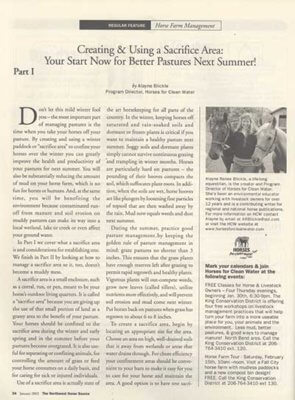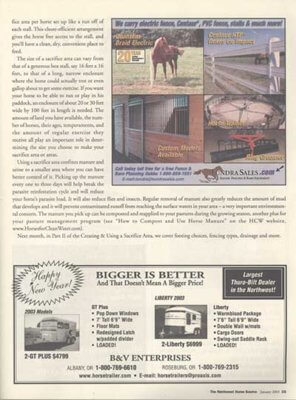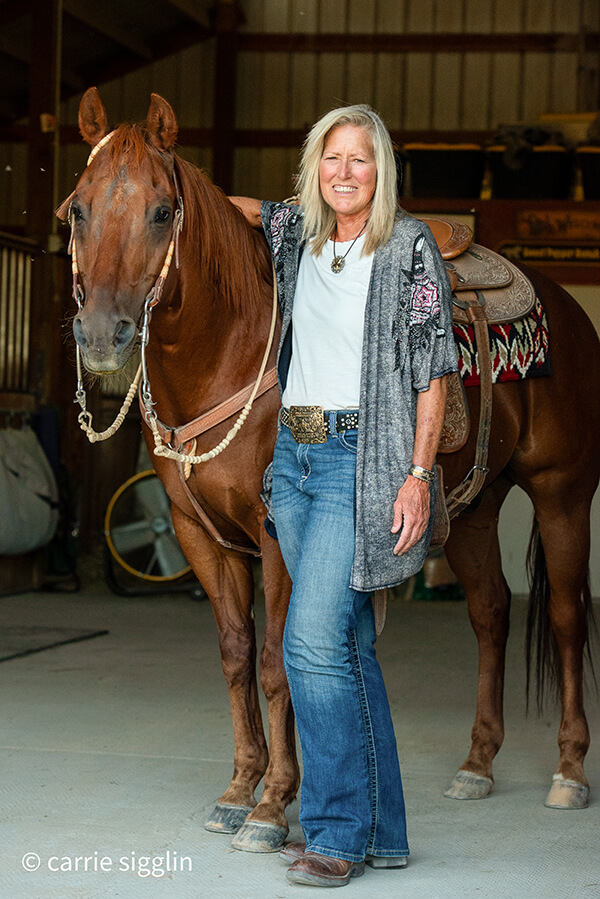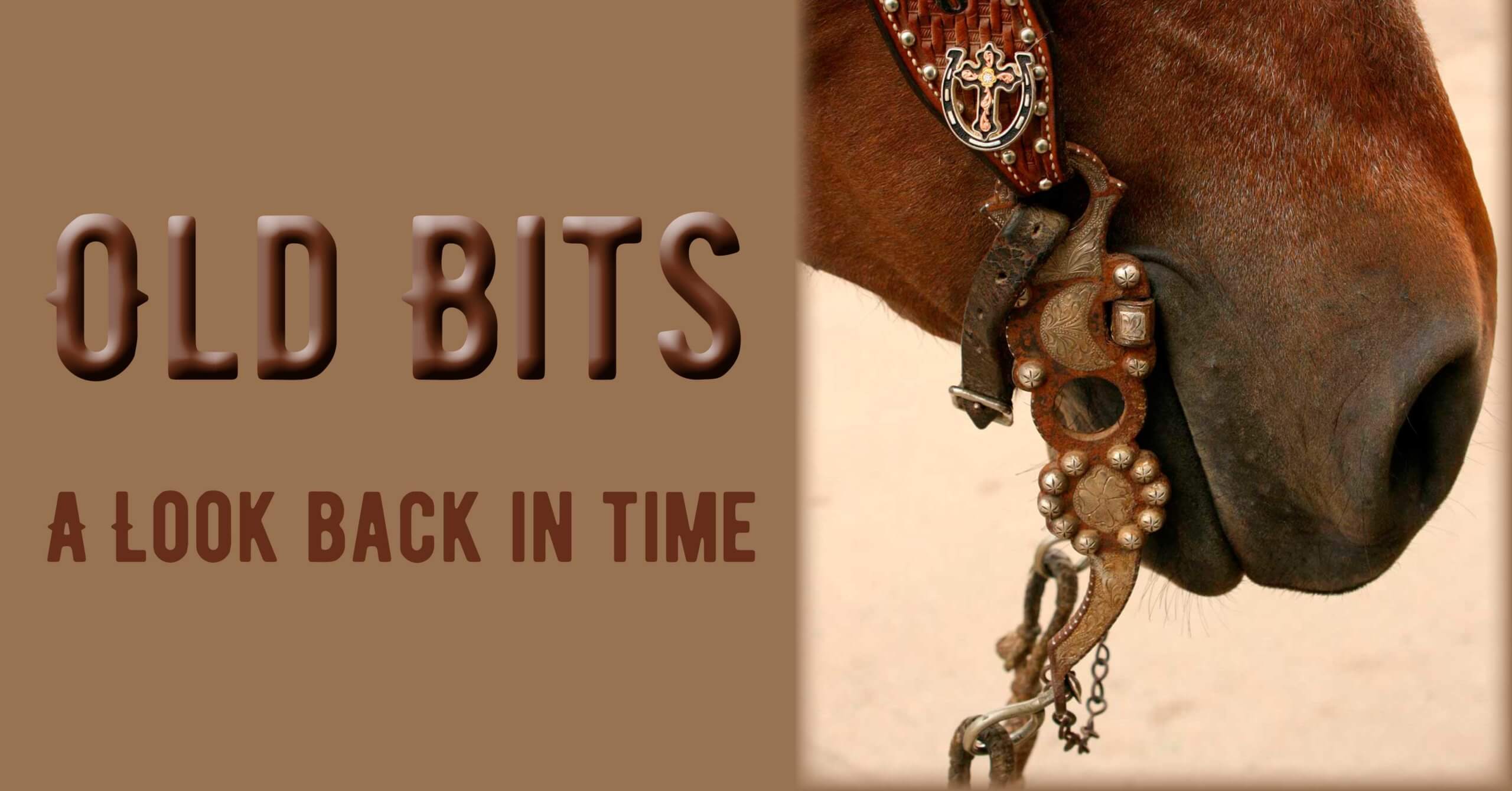Creating & Using a Sacrifice Area:
Your Start Now for Better Pastures Next Summer! Part 1
Don’t let this mild winter fool you – the most important part of managing pastures is the time when you take your horses off your pasture. By creating and using a winter paddock or “sacrifice area” to confine your horses over the winter you can greatly improve the health and productivity of your pastures for next summer. You will also be substantially reducing the amount of mud on your horse farm, which is no fun for horses or humans. And, at the same time, you will be benefiting the environment because contaminated runoff from manure and soil erosion on muddy pastures can make its way into a local wetland, lake or creek or even affect your groundwater.
In Part I we cover what a sacrifice area is and considerations for establishing one. We finish in Part II by looking at how to manage a sacrifice area so it, too, doesn’t become a muddy mess.
A sacrifice area is a small enclosure, such as a corral, run, or pen, meant to be your horse’s outdoor living quarters. It is called a “sacrifice area” because you are giving up the use of that small portion of land as a grassy area to the benefit of your pasture. Your horses should be confined to the sacrifice area during the winter and early spring and in the summer before your pastures become overgrazed. It is also useful for separating or confining animals, for controlling the amount of grass or feed your horse consumes on a daily basis, and for caring for sick or injured individuals.
Use of a sacrifice area is actually state of the art horse keeping for all· parts of the country. In the winter, keeping horses off saturated and rain-soaked soils and dormant or frozen plants is critical if you want to maintain a healthy pasture next summer. Soggy soils and dormant plants simply cannot survive continuous grazing and trampling in winter months. Horses are particularly hard on pastures – the pounding of their hooves compacts the soil, which suffocates plant roots. In addition, when the soils are wet, horse hooves act like plungers by loosening fine particles of topsoil that are then washed away by the rain. Mud now equals weeds and dust next summer.
During the summer, practice good pasture management by keeping the golden rule of pasture management in mind: graze pastures no shorter than 3 inches. This ensures that the grass plants have enough reserves left after grazing to permit rapid regrowth and healthy plants. Vigorous plants will out-compete weeds, grow new leaves (called tillers), utilize nutrients more effectively, and will prevent soil erosion and mud come next winter. Put horses back on pastures when grass has regrown to about 6 to 8 inches.
To create a sacrifice area, begin by locating an appropriate site for the area. Choose an area on high, well-drained soils that is away from wetlands or areas that water drains through. For chore efficiency your confinement areas should be convenient to your barn to make it easy for you to care for your horse and maintain the area. A good option is to have one sacrifice area per horse set up like a run off of each stall. This chore-efficient arrangement gives the horse free access to the stall, and you’ll have a clean, dry, convenient place to feed.
The size of a sacrifice area can vary from that of a generous box stall, say 16 feet x 16 feet, to that of a long, narrow enclosure where the horse could actually trot or even gallop about to get some exercise. If you want your horse to be able to run or play in his paddock, an enclosure of about 20 or 30 feet wide by 100 feet in length is needed. The amount of land you have available, the number of horses, their ages, temperaments, and. the amount of regular exercise they receive all play an important role in determining the size you choose to make your sacrifice area or areas.
Using a sacrifice area confines manure and urine to a smaller area where you can have better control of it. Picking up the manure every one to three days will help break the parasite reinfestation cycle and will reduce your horse’s parasite load. It will also reduce flies and insects. Regular removal of manure also greatly reduces the amount of mud that develops and it will prevent contaminated runoff from reaching the surface waters in your area – a very important environmental concern. The manure you pick up can be composted and reapplied to your pastures during the growing season, another plus for your pasture management program (see “How to Compost and Use Horse Manure,, on the HCW website, www.HorsesforCleanWater.com).
Next month, in Part II of the Creating & Using a Sacrifice Area, we cover footing choices, fencing types, drainage and more.


Published in the January 2003 Issue of the Northwest Horse Source Magazine – Horse Farm Management Column

Alayne Blickle began in the 1990’s as a pioneer in water conservation and natural resources conservation by creating the entrepreneurial consulting business, Horses for Clean Water, an award-winning internationally acclaimed education program that looks for horse-healthy, nature-based solutions to land management challenges. She continues this work today partnering with agencies, organizations, and horse owners throughout North America and worldwide. She is a regularly contributing writer and photojournalist to several equine publications.
Alayne lives with her horse trainer husband, Matt Livengood, in southwestern Idaho where they raise and train AQHA horses and mustangs on their eco-friendly horse ranch. Contact her through the Horses for Clean Water website or through their ranch website Sweet Pepper Ranch.
For more information contact Alayne at [email protected] or 206-909-0225.






